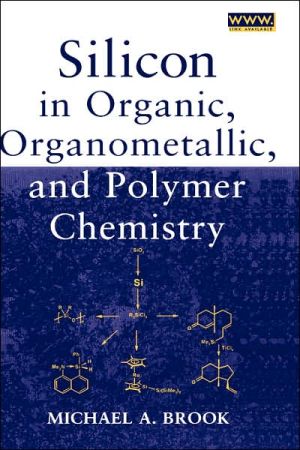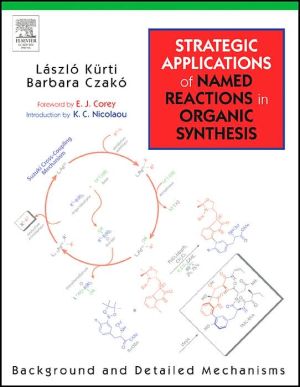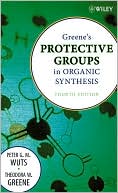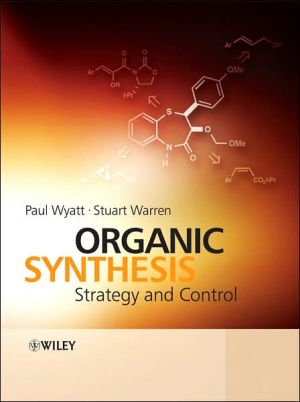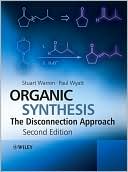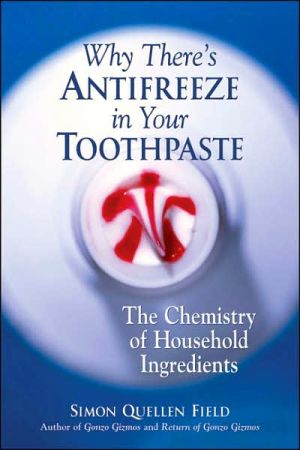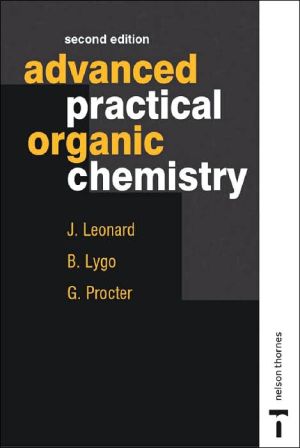Organosilicon Chemistry
A comprehensive, up-to-date reference to synthetic applications of organosilicon chemistry Organic, organometallic, and polymer chemistry as well as materials science all utilize silicon in various forms, yet there is little cross-fertilization of ideas and applications among the disciplines. This book presents a much-needed overview of silicon chemistry, allowing fundamental and applied scientists to take full advantage of progress made within and outside their primary fields of expertise....
Search in google:
A comprehensive, up-to-date reference to synthetic applications of organosilicon chemistry Organic, organometallic, and polymer chemistry as well as materials science all utilize silicon in various forms, yet there is little cross-fertilization of ideas and applications among the disciplines. This book presents a much-needed overview of silicon chemistry, allowing fundamental and applied scientists to take full advantage of progress made within and outside their primary fields of expertise. With an emphasis on the preparation and reactivity of silicon compounds in organic, organometallic, and polymer chemistry, the author examines a broad range of useful topics-from mechanisms to syntheses of and syntheses using different organofunctional silanes. Numerous schemes as well as up-to-date examples from academia and industry will help readers to solve current synthetic problems and explore ideas for future research. Clear, concise coverage includes: * The mechanistic basis for the development of new silicon-based reactions * Formation and cleavage of silane reagents and functional siliconheteroatom compounds * Silicones, silica, polysilanes, and other silicon-containing polymers * Properties of molecules containing silicon, including bioactivity * Methods for the preparation of Si-C compounds * Silicon in organic synthesis * An extensive functional group index for easy access to functional group transformations Phillip Magnus In recent years there have been several books published that describe the various topical uses of silicon in organic synthesis. All of these books have been useful, but they did not present the broader picture of how the chemistry of the element silicon has had a major impact on many technologies. The author refers to some earlier "classical" books on silicon chemistry, particularly Eaborn's text of the 1960s, that set a very high and comprehensive standard by which to be judged. Without a doubt, Michael Brook has met this standard. This book was a pleasure to read. It is very well written in a relaxed and chatty style that conveys the obvious deep interest and delight the author brings to the subject. There are an impressive number of references to substantiate this scholarly text. One minor point that might (subjectively make the book even better would be to place Chapter 14 (Electronic Effects of Silyl Group earlier since it so germane to all of the book. The price is high, but not unreasonably so, and the book can quite rightly claim to be the "Eaborn" of the 2000s.
ForewordxxiPrefacexxiiiPart IFundamentals of Silicon Reactivity: Reactive Intermediates and Reaction Mechanisms11.Organosilanes: Where to Find Them, What to Call Them, How to Detect Them31.1.Introduction31.2.References51.3.Nomenclature91.4.NMR Characterization of Silicon-Containing Species131.5.References232.Atomic and Molecular Properties of Silicon272.1.Atomic Properties272.2.Orbital Interactions of Silicon: Atomic Orbitals292.3.Molecular Properties of Silicon312.4.References363.Silicon-Based Reactive Intermediates393.1.Silylenes (R[subscript 2]Si:)403.2.Silylium Ions (R[subscript 3]Si[superscript +])483.3.Silyl Radicals (R[subscript 3]Si[superscript .])523.4.Silyl Anions (R[subscript 3]Si[superscript -])553.5.[pi] Bonds to Silicon613.6.References794.Extracoordination at Silicon974.1.Extracoordination: Silicon as a Lewis Acid974.2.More Complex Pentacoordinate Compounds994.3.Reactivity of Extracoordinate Species: Electronic Distribution1014.4.Reactions of Pentacoordinate Systems1034.5.Hexacoordinate Compounds1064.6.Higher Extra Coordinate Species1104.7.References1115.Reaction Mechanisms for Nucleophilic Substitution at Silicon1155.1.Reaction Mechanisms in Carbon Chemistry1155.2.The Study of Stereochemistry, Mechanism, and Silicon: Enantiopure Silanes1165.3.The Role of Extracoordinate Silicon in Nucleophilic Substitution1215.4.Silicon as an Inorganic Element (Rather Than as a Carbon Analogue): Understanding the Stereochemical Outcome1225.5.The Mechanism of Substitution in the Presence of Silaphilic Catalysts1335.6.References137Part IIThe Formation and Cleavage of Non-Carbon Bonds to Silicon: Applications in Organic and Polymer Chemistry1436.Silicon and Transition Metal Chemistry1456.1.Metal Complexes without Si-Metal Bonds1456.2.[eta superscript 1]-Si-Metal Complexes1506.3.Some Reactions of [eta superscript 1]-Si-Metal Complexes1536.4.Transition Metal Complexes of Stable Silyl Species1556.5.Stabilization of Silicon-Based Reactive Intermediates1566.6.References1637.Hydrosilanes as Reducing Agents1717.1.Si-H Bond Strengths1717.2.Reduction of Organic Functional Groups1727.3.Reduction of Carbocations1757.4.Formation of SiO Bonds Using Hydrosilanes1757.5.References1858.Replacing H with Si: Silicon-Based Reagents1898.1.Trimethylsilyl-Based Reagents1908.2.Silyl Protecting Groups1988.3.Silicon-Tethered Reactions: A Temporary Connection2098.4.Silicon-Protected Nucleophiles I: Silyl Nitronates2158.5.Silicon-Protected Nucleophiles II: Silyl Enol Ethers (Alkenoxysilanes, Enolsilanes)2158.6.References2399.Silicones2569.1.Uses of Silicones2579.2.General Routes to Silicone Cyclics and Oligomers2589.3.Preparing/Modifying High-Molecular-Weight Silicones2619.4.Crosslinking of Silicones2829.5.Silicone-Organic Copolymers2929.6.Degradative Reactions of Silicones2949.7.References29810.Siloxanes Based on T and Q Units30910.1.Silica (Q Units)30910.2.Crystalline and Amorphous Silica30910.3.Ormosils: Organic Modified Sol-Gels32010.4.Silsesquioxanes (RSiO[subscript 3/2]: T Units)32110.5.References33111.Other Silicon-Containing Polymers34011.1.Organic Polymers with Pendant Silyl Groups34011.2.Disilanes34311.3.Polysilanes34711.4.Carbosilane Polymers35511.5.Nitrogen-Containing Silicon Polymers: The Polysilazanes36511.6.Silicon Carbide36611.7.The Preparation of Silicon36711.8.References367Part IIIThe Formation and Cleavage of Silicon-Carbon Bonds: Applications in Organic Synthesis37912.Formation of Si-C Bonds: The Synthesis of Functional Organosilanes38112.1.The Direct Process38212.2.Grignard-Type Reactions38512.3.Other Ways of Generating Carbanions38812.4.Silyl Anions39412.5.Acylsilanes39512.6.Transition Metal-Catalyzed Reactions39712.7.Addition of Cyanotrimethylsilane to Alkynes40012.8.Hydrosilylation40112.9.Formation of Si-C bonds - Some Unusual Approaches42212.10.Functional Organosilanes Prepared from Organosilanes42212.11.Functional Silanes by Oxidation44012.12.References44213.Silicon in a Biological Environment45913.1.Inorganic Silicon Compounds: Silica45913.2.Organic Silicon Compounds46213.3.References47314.Silicon in the Organic World: Electronic Effects of Silyl Groups48014.1.Magnitude of Electronic Effects48014.2.Stabilization of Carbenes, Ions, and Radicals48314.3.References50315.Rearrangements51115.1.Anionic Rearrangements51115.2.Cationic Rearrangements52015.3.Epoxysilanes: Rearrangements and Other Reactions52415.4.Radical Rearrangements52615.5.Carbene Rearrangements52815.6.Concurrent Rearrangements53015.7.Acylsilanes--Silyl Functional Groups That Participate Extensively in Rearrangement Reactions53915.8.References54316.Cleavage of Si-C Bonds55216.1.Temporary Steric Control by Silyl Groups: Now You See It, Now You Don't55216.2.Oxidative Cleavage of Silyl Groups (C-Si[right arrow]C-OH)55816.3.Nucleophile-Induced Desilylation (C-Si[right arrow]C-C)56116.4.Electrophilic-Induced Desilylation (C-Si[right arrow]C-H, C-X, C-C)56916.5.References596Indices of Functional Group Transformations608Subject Index644
\ From the Publisher"...this book provides a good 'state-of-the-art' compilations and evaluation at the turn of the century. This work should be included in any chemistry reference collection." (Choice, Vol. 38, No. 8, April 2001)\ "This book was a pleasure to read. It is very well written in a relaxed chatty style that conveys the obvious deep interest and delight the author brings to the subject...the book can quite rightly claim to be the 'Eaborn' of the 2000s." (Journal of the American Chemical Society, Vol. 123, No. 5, November 2000)\ In recent years there have been several books published that describe the various topical uses of silicon in organic synthesis. All of these books have been useful, but they did not present the broader picture of how the chemistry of the element silicon has had a major impact on many technologies. The author refers to some earlier "classical" books on silicon chemistry, particularly Eaborn's text of the 1960s, that set a very high and comprehensive standard by which to be judged. Without a doubt, Michael Brook has met this standard. This book was a pleasure to read. It is very well written in a relaxed and chatty style that conveys the obvious deep interest and delight the author brings to the subject. There are an impressive number of references to substantiate this scholarly text. One minor point that might (subjectively) make the book even better would be to place Chapter 14 (Electronic Effects of Silyl Group) earlier since it so germane to all of the book. The price is high, but not unreasonably so, and the book can quite rightly claim to be the "Eaborn" of the 2000s. (Phillip Magnus, University of Texas at Austin)\ "...Brook discusses selected topics regarding synthesis he considers of most use to graduate students and practicing chemists." (SciTech Book News, Vol. 24, No. 4, December 2000)\ "...this is a completely successful book..." (Angewandte Chemie - International Edition, 3rd November 2000)\ \ \ \ \ \ Phillip MagnusIn recent years there have been several books published that describe the various topical uses of silicon in organic synthesis. All of these books have been useful, but they did not present the broader picture of how the chemistry of the element silicon has had a major impact on many technologies. The author refers to some earlier "classical" books on silicon chemistry, particularly Eaborn's text of the 1960s, that set a very high and comprehensive standard by which to be judged. Without a doubt, Michael Brook has met this standard. This book was a pleasure to read. It is very well written in a relaxed and chatty style that conveys the obvious deep interest and delight the author brings to the subject. There are an impressive number of references to substantiate this scholarly text. One minor point that might (subjectively) make the book even better would be to place Chapter 14 (Electronic Effects of Silyl Group) earlier since it so germane to all of the book. The price is high, but not unreasonably so, and the book can quite rightly claim to be the "Eaborn" of the 2000s.\ \ \ Choice...this book provides a good 'state-of-the-art' compilations and evaluation at the turn of the century. This work should be included in any chemistry reference collection.\ \ \ \ \ SciTech Book News...Brook discusses selected topics regarding synthesis he considers of most use to graduate students and practicing chemists.\ \ \ \ \ Angewandte Chemie...this is a completely successful book...\ \ \ \ \ Journal of the American Chemical SocietyThis book was a pleasure to read. It is very well written in a relaxed chatty style that conveys the obvious deep interest and delight the author brings to the subject...the book can quite rightly claim to be the 'Eaborn' of the 2000s.\ \ \ \ \ Phillip MagnusIn recent years there have been several books published that describe the various topical uses of silicon in organic synthesis. All of these books have been useful, but they did not present the broader picture of how the chemistry of the element silicon has had a major impact on many technologies. The author refers to some earlier "classical" books on silicon chemistry, particularly Eaborn's text of the 1960s, that set a very high and comprehensive standard by which to be judged. Without a doubt, Michael Brook has met this standard. This book was a pleasure to read. It is very well written in a relaxed and chatty style that conveys the obvious deep interest and delight the author brings to the subject. There are an impressive number of references to substantiate this scholarly text. One minor point that might (subjectively make the book even better would be to place Chapter 14 (Electronic Effects of Silyl Group earlier since it so germane to all of the book. The price is high, but not unreasonably so, and the book can quite rightly claim to be the "Eaborn" of the 2000s.\ \ \ \ \ Journal of the American Chemical SocietyThis book was a pleasure to read. It is very well written in a relaxed chatty style that conveys the obvious deep interest and delight the author brings to the subject...the book can quite rightly claim to be the 'Eaborn' of the 2000s.\ \ \ \ \ SciTech Book News...Brook discusses selected topics regarding synthesis he considers of most use to graduate students and practicing chemists.\ \ \ \ \ BooknewsDrawing from his course first for graduate students in organic synthesis and later for scientists in the silicon industry, Brook (chemistry, McMaster U., Hamilton, Ontario) discusses selected topics regarding synthesis he considers of most use to graduate students and practicing chemists. He covers the fundamentals of silicon reactivity: reactive intermediates and reaction mechanisms; the formation and cleavage of non-carbon bonds to silicon with applications in organic and polymer chemistry; and the formation and cleavage of silicon- carbon bonds with applications in organic synthesis. His goal is to summarize recent developments made in all three fields of chemistry. Annotation c. Book News, Inc., Portland, OR (booknews.com)\ \
